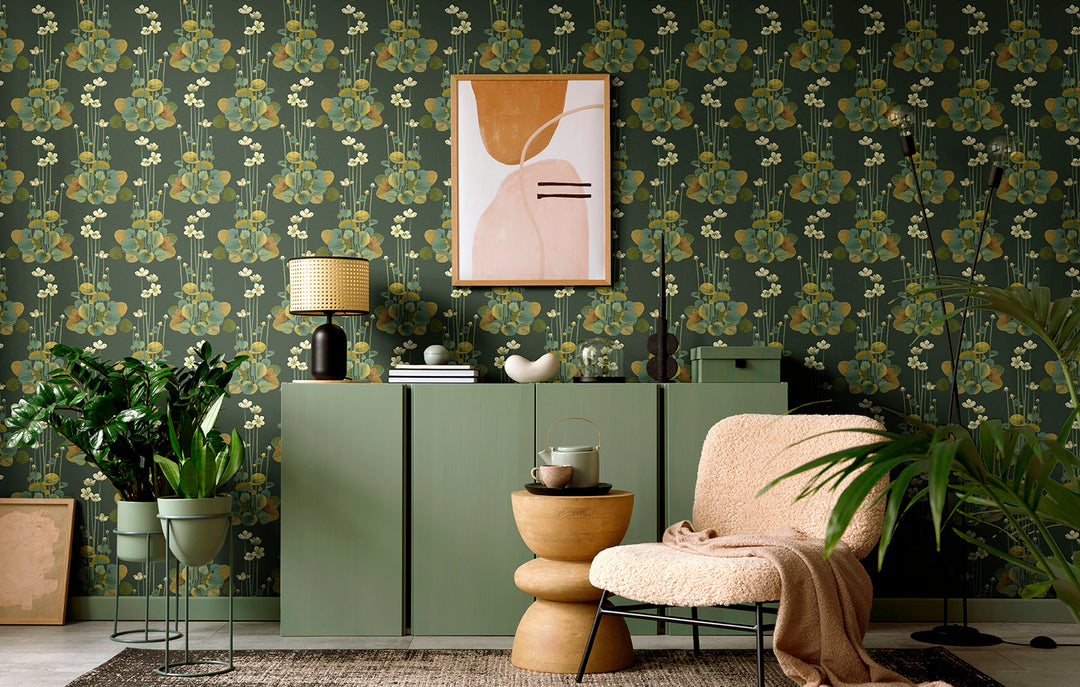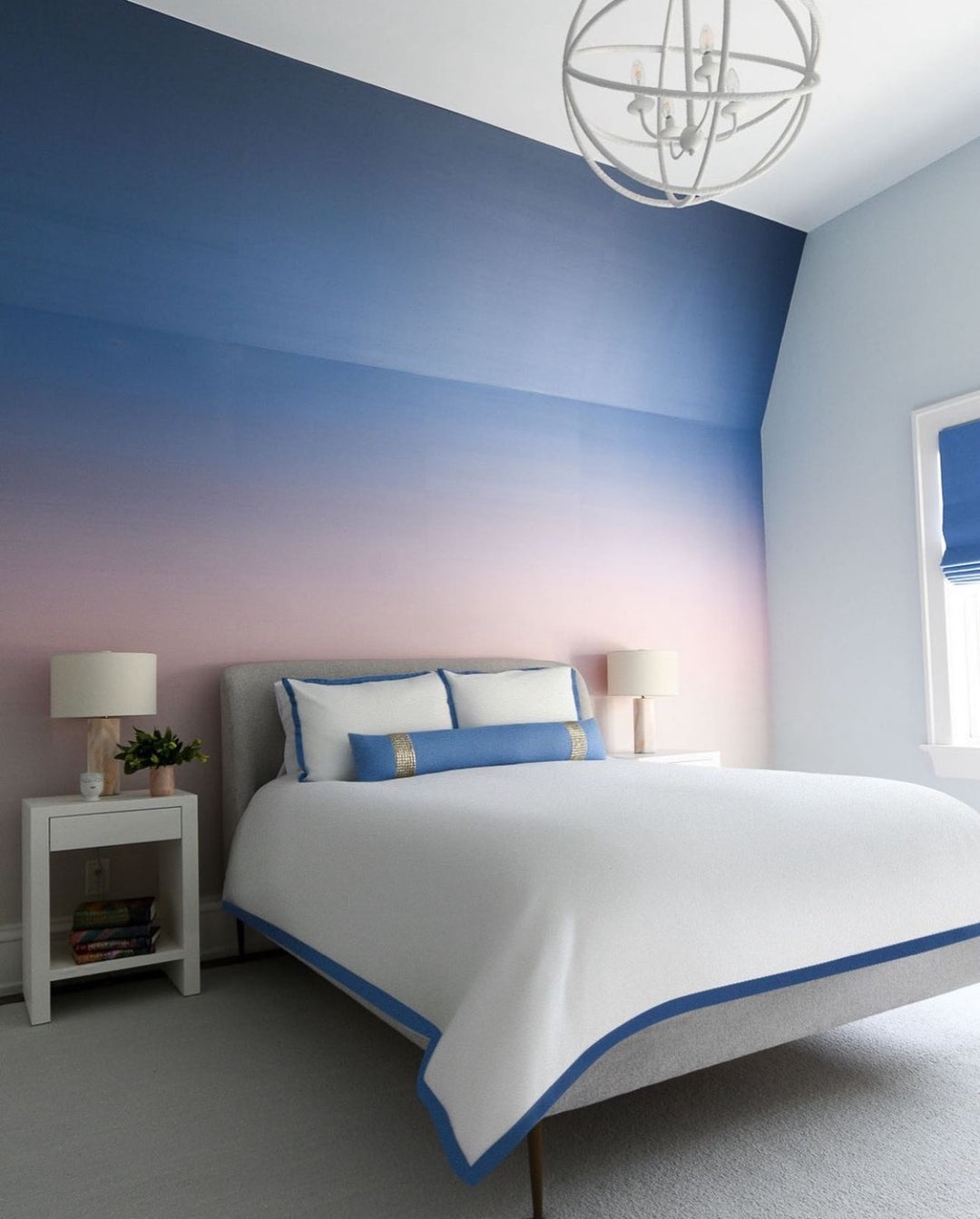Our Story
“Wallpaper, huh?”
That’s the question many people asked Andi Kubacki and Josh Young at their first design trade show, in the spring of 2013.
The reaction was understandable. Maligned for its frumpy patterns and agonizing adhesives, wallpaper was long relegated to the décor dustbin. But a new generation is discovering wallpaper, and Kubacki and Young are at the vanguard of its revival. The Detroit Wallpaper Company, which they co-founded, specializes in customizable wallpaper in a broad range of modern patterns and colors that are, as its former tagline attests, “not your mother’s wallpaper.”
The company offers collections with designs ranging from bold geometric shapes to botanical imagery and patterns informed by everything from Moroccan architecture to electronic circuit boards, reflecting Kubacki and Young’s wide-ranging interests and intellectual curiosity.
Social media video produced for Microsoft by Edelman
Psych, inspired by the Rorschach inkblot test and Young’s college studies in psychology, was created from dozens of ink blots made by Kubacki and an intern that were digitally scanned and assembled into an elegant, abstract pattern. Record Shelf, at first looks like simple rows of lines, but on closer inspection turns out to be a pattern depicting vertical stacks of records — a nod to the business partners’ love of music.
Launched in 2012, The Detroit Wallpaper Company pioneered the concept of wallpaper customization. Each design is available in different paper types, from an eco-friendly material to a metallic grass cloth, that are easy to install and remove. Customers can choose from several color schemes or create their own for a combination no one else might have.
“We have a culture of customer service,” said Young. “You can have wallpaper your way, from the color to the type of material.”
The approach has resonated with interior designers, Kubacki said, who often start with a color scheme and search for a matching wallpaper, then may change the palette or furniture if they can’t find the right color.
“That was the classic struggle with wallpaper. You could find a pattern you love, but if the color wasn’t right, it wouldn’t work,” he said. “We started enabling designers to flip the script.”
Promotional video produced by HP
"I love that you can play with the colors and make it your own. They have so much to choose from. There’s something for everybody." Rachel Zimmerman, an interior designer in Detroit, is a frequent customer who appreciates the company’s graphic designs and the ability to customize.
“I love that you can play with the colors and make it your own,” she said. “They have so much to choose from. There’s something for everybody. And their price point is really good, too.”
Alessia Loffredo, owner of Detroit-based reDesign Home, said Kubacki and Young are unusually accommodating, whether that means adjusting a pattern scale or helping to refine an idea. For one job, she said, she identified a few colors she wanted to use and asked Kubacki to choose the rest.
“We got a great product back. That’s huge, especially in the design field, when you can trust somebody and they can understand your vision,” Loffredo said. “They’re really passionate about what they do, and it shows in their work and the relationships they have with designers and clients.”
The company’s products are created and manufactured at its headquarters. Technology plays a key role in the process. Orders are processed with the selected colors, paper type and size, then printed digitally and cut on a digital cutter. An interactive Excel spreadsheet that employees refer to as “the bible” tracks jobs from start to shipping, with colored dropdown menus showing project status and deadlines.
“The technologies that we use give us freedom,” said Kubacki. “We wouldn’t have been able to innovate the way we have if the technology didn’t support our business the way it has.”
The company’s blend of design house and production shop is unusual for a wallpaper business, Young said. He describes The Detroit Wallpaper Company as a hybrid of Andy Warhol and Henry Ford, an enterprise at the intersection of art and mass production.
“We’re using very commercial equipment to produce art,” Young said. “We are artists making our own stuff in a mass-produced, commercial way. But it’s an artistic endeavor from the first step.”
International ad campaign filmed for Microsoft 365
It is also a venture shaped in no small way by Detroit, a city on the upswing with a rich design legacy and relatively affordable living that is fostering a creative renaissance among artists and makers. In 2015, Detroit became the first U.S. city to receive a UNESCO “city of design” designation, an honor recognizing its design history and commitment to promoting creativity and cultural industries.
The Motor City is reflected in several of the partners’ designs, like Tirenation, a texture of tire treads arranged in a herringbone pattern that pays homage to Detroit’s auto industry, and MusicWall, comprising vintage guitars, amplifiers, synths and turntables.
“Detroit has lent a much more graphic and bold aspect to a lot of our designs,” Kubacki said. “Detroit has been notorious for ruin porn, buildings falling down and that sort of thing, but we do not promote that whatsoever.”
Added Young: “There’s this gritty perception of Detroit, and that reality does exist, but that doesn’t necessarily inform the design aesthetic so much.”
Detroit’s decades of struggle, they say, have engendered both a hardscrabble tenacity and a camaraderie among businesses — if one can succeed, that bodes well for others. There is a tremendous amount of goodwill in the city’s creative community, Young said, and a collective pride in Detroit’s resurgence.
“We have had support from all types of businesses, from retailers to interior designers, and we’ve supported makers in different ways,” he said. “There’s this very interconnected team of people.”
As the city was left behind economically over decades, the partners say, the entrepreneurs who remained behind developed a resourcefulness, an approach of doing things their own way.
“There are a lot of unconventional solutions that have happened in Detroit for a long time,” Kubacki said. “Everyone here has come to the realization that no one’s going to fix our problems for us. If we don’t fix them ourselves, they’re not going to get fixed."
Live television appearance on local Fox affiliate. RIP Jessica Starr
The Detroit Wallpaper Company's sensibilities were established and rooted in its founders’ childhoods. Kubacki grew up in Bay City and Young in Midland, small mid-Michigan cities less than 20 miles apart. The two didn’t meet until they were in their 20s, but they shared an innate creativity and entrepreneurial streak.
Kubacki started painting at age 5, winning an award in kindergarten for a large watercolor mural he created, and later sold customized calendars featuring his paintings to businesses. Kubacki’s mother was a DIY decorator with a knack for color who liked to rearrange the furniture every few months. From his housebuilder and handyman father, Kubacki acquired an aptitude for engineering and mechanical work. He was interested in studying art, but with little encouragement in his hometown for an artistic career, he got a degree in mechanical engineering instead.
Young dreamed of becoming a comic book illustrator and writer. As a child, he made his own comic books, complete with ads. His mother worked for Dow Corning and enlisted Young to make computer illustrations for her company manuals. In summers, while his parents were working, the enterprising youngster arranged rummage sales with his friends to make money, set up a water park in the yard and charged admission, and hawked the snacks that his mother bought.
“It was pure profit for me, because I certainly wasn’t giving a kickback to my mom,” he said, laughing.
Kubacki and Young met online, struck up a relationship and bought a house in Ferndale in 2002. They started binge-watching the reality show “Trading Spaces,” about two sets of neighbors who would redecorate a room in each other’s house, and that sparked an interest in the world of interior décor. At the time, Kubacki was employed by a printing company that made large banners and building wraps. He’d worked his way up in the industry from graphic designer to vice president, and along the way learned about image manipulation, production and operating large printing machines. Young was managing a golf supply website, gaining expertise in e-commerce, customer service and vendor management.
The pair was setting up an office in the basement of their home, and Young got the idea to make a large vinyl banner to cover an unsightly storage and utility area. That led to another idea: Why not make wall murals for customers? They figured they could offer murals more tasteful than the ones typically seen in suburban basements and dens, with the ubiquitous waterwheel, mountain or beach scenes.
“We wanted to bring an element of that back, but make it cool,” Young said.
The pair purchased a $40,000 printer on a credit card and bought about $3,000 worth of digital images in various categories — nature, space, cityscapes, macro textures like sand and seed pods. They planned to start a side business and keep their day jobs, but fate intervened and both lost their jobs within a few weeks. The fledgling entrepreneurs had a brand-new business, bills coming in and a mortgage payment to make. They gave themselves six months to make it work.
The partners soon had their first job, installing a mural of a Japanese bamboo path in a local woman’s house. That was followed shortly by a $2,000 job for a biotech company that wanted a large Southwest scene on one of its walls. “We were doing backflips of joy,” Young recalled.
The pair officially launched their company, Great Wall Custom Coverings, in 2004. Patterned wallpaper was still unpopular, and most clients wanted images on their walls, not flowers — so Kubacki and Young sold them what was essentially wallpaper printed with photographs. Some customers were happy with the stock images, but others had specific requests. One woman wanted her powder room to look like a public bathroom, with a wall of urinals. A private investigator requested an image of a sketchy, dark back alley behind his desk. Kubacki and Young obliged.
Soon after moving into the building we purchased in 2017

If clients wanted images they didn’t have, Kubacki would go out and take photographs. One Detroit native who owned a shop in Ohio wanted a mural showing the Ambassador Bridge, which connects Detroit with Windsor, Ontario. One afternoon in 2005, Kubacki took his digital camera to a baseball diamond near the park and started taking photos. Suddenly, a black Suburban roared onto the field and several Department of Homeland Security employees got out. Kubacki was detained and his images deleted. Undeterred, he took new ones later from another location.
“They thought I was trying to figure out how to blow the bridge up and where to put explosives. There’s a dossier in Homeland Security somewhere with my name on it because of that incident.” Kubacki added wryly: “We’re willing to do just about anything for our clients.”
For a time, Great Wall did a brisk business with bar and bat mitzvahs, turning ballrooms into personalized and aspirational fantasylands. For one young sports fanatic, they photographed the boy shooting hoops while his family cheered him on, then superimposed the images on a backdrop of an arena.
Chatting about Detroit & design in 2016
As the business grew and started taking on different work, clients began requesting reproductions of out-of-print wallpaper patterns, some of them vintage gems discovered during renovations of Detroit’s stately old homes. Clients would send a photo or provide a small scrap of wallpaper and Kubacki would scan the image, then digitally recreate the pattern and make it into panels. Great Wall became increasingly known for wallpaper reproductions, which generated new contacts and grew the company’s reputation.
But the custom work was time-consuming, and the partners increasingly wanted to create their own designs. They thought about how they could offer a customized experience with exceptional service but dial back the amount of time they spent with each client and increase volume. Inspired by Nike’s approach that allowed customers to personalize their shoes, they developed the concept for The Detroit Wallpaper Company, launching with about 70 designs.
The new company’s popularity and reach quickly eclipsed that of Great Wall, to Kubacki and Young’s surprise. It was featured in Dwell magazine, and one of Kubacki’s designs — Peepers, an anime-inspired children’s pattern depicting geometric-shaped figures with eyeballs seated in a stadium-style setting — was chosen for inclusion in the Cooper Hewitt, Smithsonian Design Museum.
In February 2017, the company moved into its newly purchased headquarters, an 8,000-square foot, high-ceilinged open space that was previously a photography studio for large vehicles. The company now has 12 full-time employees, including Kubacki and Young. They are no longer a couple, but have settled into a comfortable working relationship that draws on their complementary strengths.
Young, who’s gregarious and funny, leans toward big ideas and abstract, organic designs. Kubacki is mathematically minded, inclined to order and structure, and is often tasked with bringing the pair’s ideas to fruition. Young describes the pair as the “Stevie Nicks and Lindsey Buckingham of wallpaper,” with him the twirling, ethereal Nicks and Kubacki the virtuosic, focused Buckingham.
“Andi can take something and bang it out so quickly, but it’s so polished and perfect,” Young said. “It’s that happy medium that rarely happens.”
High Point Market promotional video with the amazing Courtney Lake
The pair then launched a new trade-only line, Westfall & Kitson (after Kubacki’s and Young’s mothers’ maiden names, respectively). It includes designs derived from Kubacki’s pastel drawings, watercolor paintings and suminagashi prints, made from a Japanese process of marbling paper with water and ink. Featuring subtler colors and smaller patterns, it is not intended for customization. The idea was partly to provide a product for customers who might be overwhelmed by too many options, Young said, but it also signifies a maturity and confidence in the company’s designs.
“It’s a subtle shift, but I think it’s also meaningful in our growth and where we’re going,” Young said. “Our hope is that people want to buy into the aesthetic that we’re offering.
The partners say wallpaper turned a corner in the fall of 2013, a time when fashion designers were introducing more printed fabrics. Fashion trends that stick around become broader design trends, making their way into people’s homes a bit later. But Kubacki and Young realize that like fashion, wallpaper is cyclical, and what’s stylish on a wall today might be stale tomorrow (sponge-painting, anyone?).
Their mission, they say, is to keep innovating wallpaper so that every time favor starts to swing in a different direction, they’ll have something new and better to offer. That could be wallpaper, 3D printing, maybe something they haven’t dreamed up yet.
“Who knows, maybe we’ll start printing walls and making houses,” Kubacki said. “We might do something else. But we’re always going to do something that makes us happy. If we’re not having fun, there’s something wrong.”
This story originally appeared in 2017 as part of Microsoft's Story Lab series, which featured creative companies using tech in interesting ways.
Written by Suzanne Choney (with minor, timely edits)








